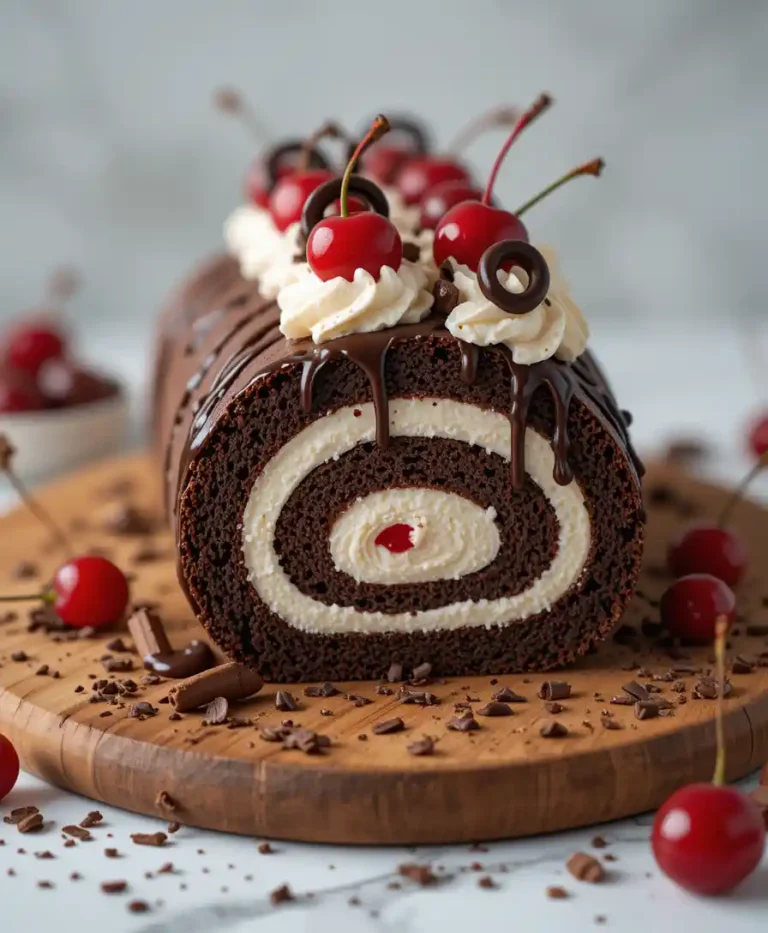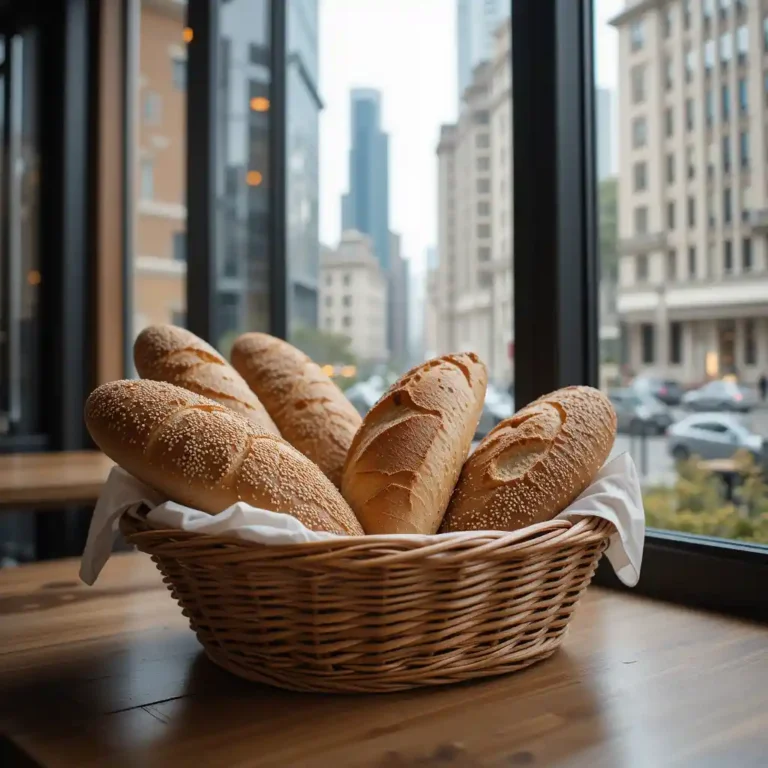Iranian Desserts
Iranian desserts aren’t just food — they’re a journey into the heart of Persian culture.
Have you ever tasted something so rich in flavor that it feels like a story unfolding on your tongue? That’s exactly what happens when you try traditional Persian sweets. However, here’s the problem: most people outside Iran have no idea how rich, diverse, and delicious these desserts truly are. They only hear about baklava or maybe saffron ice cream, missing out on a whole world of sweet treasures.
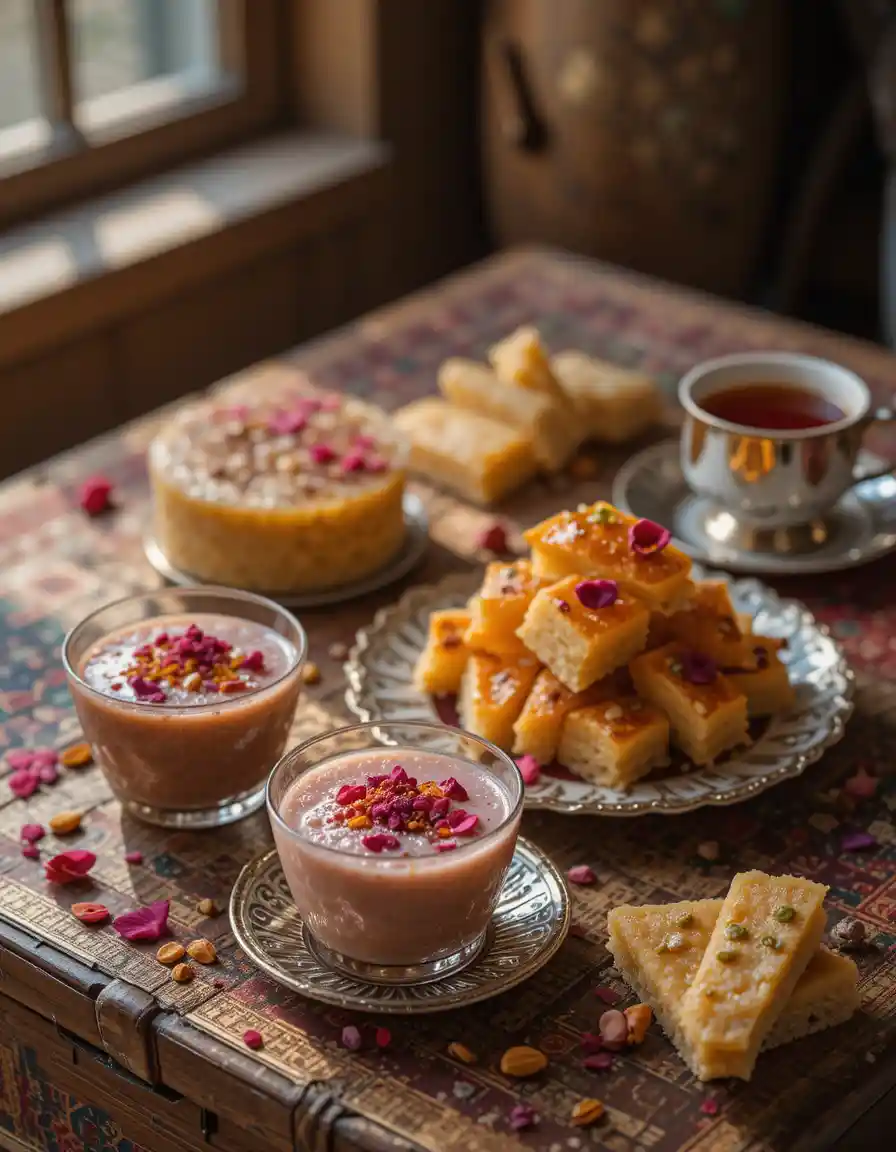
In this guide, you’ll finally discover the full richness of Iranian desserts — from delicate zoolbia bamieh soaked in saffron syrup, to the refreshing faloodeh Shirazi with its icy rosewater threads. We’ll delve into the history, the unique ingredients such as pistachios and rosewater, and the cultural traditions that make Persian sweets so special.
Whether you’re a food lover, a curious traveler, or someone looking to bring new flavors into your kitchen, this article will give you an exclusive look into the irresistible world of Iranian desserts. Let’s get started — as Iranians say: “Nush-e Jan!” — enjoy every bite!
Table of Contents
Recipe Information: Iranian Desserts
- Preparation Time: 15–30 minutes (varies by recipe)
- Cooking Time: 20–60 minutes (depending on dessert type)
- Total Time: 35 minutes to 1.5 hours
- Type: Dessert
- Cuisine: Iranian / Persian
- Recipe Yield: 4–8 servings (varies by dessert)
- Calories: 150–400 kcal per serving (depending on ingredients)
A Brief History of Iranian Sweets
Persian sweets have been part of daily life since the time of the Achaemenid Empire, over 2,500 years ago. Back then, sugar wasn’t even common — people used honey, dates, and fruits to sweeten their dishes.
As the Persian Empire expanded, it absorbed flavors and techniques from India, Central Asia, and the Arab world. The Silk Road played a huge role, too, bringing exotic spices like saffron, cardamom, and cinnamon straight into Persian kitchens. Over time, Iranian chefs mastered the art of blending these rich flavors into beautiful, balanced desserts that became famous far beyond the country’s borders.
What makes Persian sweets different? It’s the harmony. You won’t find overpowering sugar here. Instead, you get subtle sweetness mixed with floral notes like rosewater (golab) and bright flavors from citrus peels, almonds, and pistachios. Every bite tells a story of tradition, hospitality, and celebration.
Even today, Iranian desserts are more than just after-meal treats. They appear at weddings, Nowruz (Persian New Year), religious holidays, and family gatherings — always served with a hot glass of black tea.

Why Iranian Desserts Are So Unique
Iranian desserts stand out because they are not just about sweetness; they are about balance, elegance, and tradition. Unlike many Western sweets that rely heavily on sugar and cream, Persian desserts focus on delicate flavors that tell a story with every bite.
The use of saffron, known as “red gold,” brings not only a beautiful golden color but also a subtle, luxurious aroma that is instantly recognizable. Rosewater adds a floral note that feels light and refreshing, while cardamom gives a warm, slightly spicy undertone.
What also sets Iranian desserts apart is the deep cultural connection. In Persian culture, sweets are more than just food; they are a symbol of hospitality, celebration, and community. Whether served with hot black tea during afternoon visits or presented at weddings and religious ceremonies, these desserts play an important role in bringing people together.
Each region of Iran has developed its unique varieties based on local ingredients and traditions. From the rich, nutty Sohan of Qom to the refreshing Faloodeh of Shiraz, the diversity within Iranian desserts is as wide as the country itself.
Iranian sweets respect the idea that desserts should complement the meal, not overpower it. They are often light, fragrant, and served in small portions, leaving a lasting impression without overwhelming the senses.
Trending Recipes Now
Top 9 Must-Try Iranian Desserts
Whenever I think about Persian desserts, I can’t help but feel a bit nostalgic. These are the sweets I grew up making with my family — each one carrying its own story, tradition, and unforgettable flavor. If you’re ready to explore the true soul of Iranian sweets, here are 9 of my absolute favorites you simply have to try.
1. Sholezard
Sholezard is a traditional Persian saffron rice pudding. It is made by cooking rice slowly with sugar, saffron, rosewater, and cardamom until it reaches a creamy consistency. Typically decorated with cinnamon designs and chopped pistachios, Sholezard is often prepared as part of religious offerings, celebrations, or to fulfill vows, making it both a culinary and spiritual experience.
2. Gaz
Gaz is a nougat-like sweet that originated in Isfahan. Traditionally made with sap from the Angebin plant, sugar, egg whites, rosewater, and generous amounts of pistachios or almonds, Gaz offers a soft, chewy texture with a subtle floral sweetness.
3. Halva
Persian Halva is a dense, smooth confection made by slowly roasting wheat flour in butter or oil, then blending it with a syrup of sugar, saffron, rosewater, and cardamom. Often served during religious ceremonies and memorials, Halva carries a sense of comfort and tradition in every spoonful.
4. Noghl
Noghl consists of almonds or other nuts coated in a crisp sugar shell, often lightly flavored with rosewater. These bite-sized sweets are commonly used at weddings, where they are thrown over the bride and groom as a symbol of joy and prosperity.
5. Masghati
Masghati is a soft, jelly-like sweet from southern Iran, especially popular in Bandar Abbas and Shiraz. It is made with starch, sugar, rosewater, saffron, and sometimes decorated with chopped pistachios or dried rose petals. Its light, chewy texture and delicate flavor make it a delightful treat with tea.
6. Koloocheh
Koloocheh are Persian stuffed cookies filled with sweetened ground walnuts, sugar, cinnamon, and cardamom. The outer dough is soft and slightly crumbly, while the filling offers a warm, spiced sweetness. Variations exist across different regions, with Lahijan’s version being especially famous.
7. Nan-e Berenji
Nan-e Berenji, or rice flour cookies, are a popular Nowruz treat. Made from rice flour, sugar, eggs, and rosewater, these cookies are naturally gluten-free and have a melt-in-your-mouth texture. Often topped with a few poppy seeds, they are enjoyed with a cup of black tea.
8. Qottab
Qottab is a traditional pastry from Yazd. These crescent-shaped treats are filled with a mixture of ground almonds, powdered sugar, and cardamom, then deep-fried and dusted with powdered sugar. Their tender texture and rich filling make them a favorite during holidays and special occasions.
9. Shir Berenj
Shir Berenj is a simple yet elegant rice pudding made by cooking rice in milk, sweetened lightly with sugar, and flavored with rosewater. Often served chilled, it provides a cool, creamy finish to any meal, especially during the warmer months.
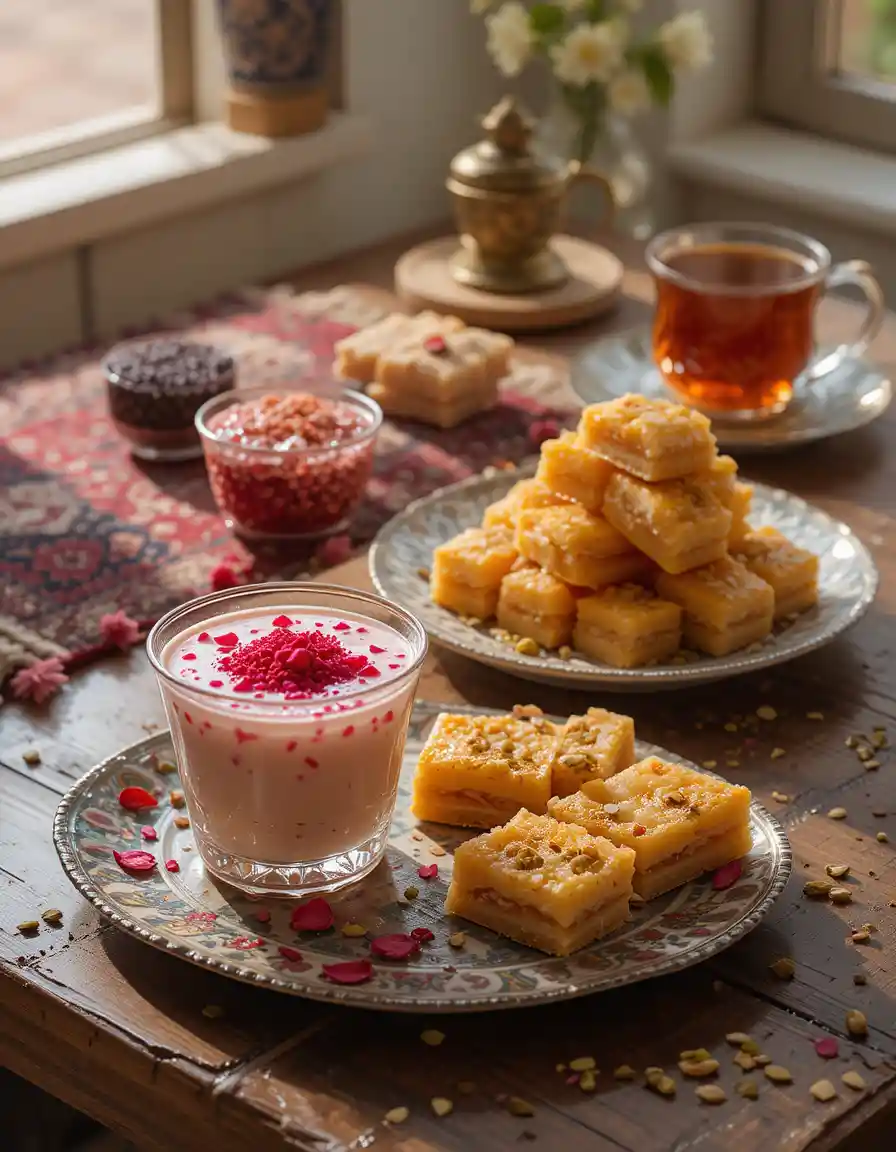
Where to Try Authentic Iranian Desserts
If you really want to taste the heart and soul of Iranian sweets, your best bet is to visit the local sweet shops and markets where these desserts have been crafted for generations. Here’s a quick guide to some of the best places across Iran to find the authentic flavors you’ve read about:
1. Sweet Shops in Tehran
Tehran, the capital, is full of traditional qanduni (confectionery) shops where you can find everything from Gaz to Baghlava Yazdi. Places like Shahrzad Sweet Shop and Mahallati Confectionery are famous among locals for their fresh, high-quality Persian desserts. Drop by for a box of Nan-e Berenji or some Zoolbia & Bamieh, especially during Ramadan.
2. Yazd — The City of Sweets
Yazd is often called the Persian desert city, but it’s also the dessert capital. You simply can’t miss tasting Qottab, Baghlava Yazdi, and Gaz here. Sweet shops like Shirini Berenji Yazd and Sohan-e Asali have been delighting people for decades. If you’re lucky, you might get to try homemade versions served in family-run bakeries.
3. Isfahan’s Famous Gaz
Isfahan is synonymous with Gaz, the famous Persian nougat. Head to Gaz-e Isfahan, Haj Mohammad Ali, for some of the best quality Gaz packed with fresh pistachios and rosewater aroma.
4. Local Bazaars & Family Kitchens
Don’t underestimate the magic of local bazaars and homemade sweets. Many families sell their recipes in small stalls during festivals or Nowruz (Persian New Year). If you get invited to a Persian home, expect an array of sweets — that’s where the real, unfiltered flavors shine.
So next time you crave a taste of Persian sweets, skip the ordinary bakery and find your way to one of these authentic spots.
Trending Recipes
Health Benefits of Traditional Persian Ingredients
Iranian desserts wouldn’t be what they are without their unique ingredients, many of which have been cherished not just for flavor but also for their health-boosting properties. When you enjoy a Persian sweet, you’re also getting a little gift from nature’s pharmacy. Here are some of the key ingredients that make Iranian desserts special, along with the benefits they bring:
Saffron — The Golden Spice
Known as the “red gold” of Persia, saffron isn’t just famous for its rich aroma and beautiful color. It’s also packed with antioxidants that help improve mood, reduce stress, and may even support heart health. A pinch of saffron in your Sholeh Zard or Halva doesn’t just taste amazing — it’s a little mood lifter too.
Rosewater — Floral and Soothing
Rosewater is the signature scent of many Persian sweets like Faloodeh and Gaz. Beyond its lovely aroma, rosewater has anti-inflammatory and calming properties. It’s often used to soothe digestion and ease headaches, making your dessert experience both tasty and gentle on your body.
Pistachios — The Nutty Powerhouse
Pistachios are everywhere in Iranian desserts — from Gaz to Baghlava Yazdi. These nuts are rich in healthy fats, protein, fiber, and antioxidants. They support heart health, help lower cholesterol, and provide a satisfying crunch that’s good for you.
Cardamom — The Sweet Spice
Cardamom adds a warm, citrusy note to many sweets like Koloocheh and Halva. This spice helps with digestion, fights inflammation, and even has antibacterial properties. It’s a little secret that Persian grandmas swear by for balancing sweetness with health benefits.
Dates — Natural Sweetness and Energy
Used in desserts like Ranginak, dates are a natural sweetener loaded with fiber, vitamins, and minerals. They provide quick energy and help regulate digestion, much better than refined sugar. Enjoying dates in sweets means indulging without the guilt.
The Latest Recipes
Stranded on a Mountain
Chocolate Swiss Roll Cake
Common Mistakes When Making Iranian Desserts
Even though Persian desserts aren’t complicated, a few small mistakes can easily throw off the flavors or textures. I’ve made most of these mistakes myself when I first started — so let me help you avoid them.
1️⃣ Overusing Rosewater
Rosewater is delicate — but a heavy hand can make your dessert taste like perfume. Always start small. Usually, one to two teaspoons are enough for most recipes. Remember, you want a subtle floral aroma, not something that overpowers everything else.
2️⃣ Burning the Saffron
Saffron is precious and burns quickly if you apply direct heat. Never add saffron directly into hot oil or syrup. Instead, bloom it in warm (not boiling) water to gently release its color and aroma. This way, you get that beautiful golden color without any bitterness.
3️⃣ Using Stale Nuts
Freshness matters more than you think. Old nuts taste bitter and can ruin even the most carefully made Baghlava or Gaz. Always check your pistachios, almonds, and walnuts before adding them to your mixture. If in doubt, toast them lightly to refresh their flavor.
4️⃣ Rushing Rice-Based Desserts
Desserts like Sholeh Zard and Shir Berenj need time. If you try to speed things up, you’ll end up with undercooked rice or a watery texture. Low heat, slow simmering, and frequent stirring are key to getting that creamy, comforting consistency.
5️⃣ Not Controlling Syrup Consistency
For syrupy desserts like Zoolbia & Bamieh, getting the syrup right is crucial. If it’s too thin, your sweets won’t absorb it; if it’s too thick, they’ll become overly sticky and heavy. Aim for a syrup that’s slightly sticky but still runs off the spoon easily.
6️⃣ Skipping the Proper Storage
Persian desserts are often made for special occasions and shared days later. If you don’t store them correctly, moisture or air can ruin the texture. Always keep syrupy desserts refrigerated and dry cookies or sweets in airtight containers.
7️⃣ Ignoring Ingredient Quality
In Persian sweets, each ingredient shines. Using low-quality saffron, fake rosewater, or processed sugar will show in the final result. It’s always worth sourcing authentic ingredients — your taste buds will notice the difference immediately.
By avoiding these common mistakes, you’ll be one step closer to mastering the beautiful world of Iranian desserts. And like we always say in Persian kitchens — saboor bāsh (be patient), because good sweets are always worth the wait.
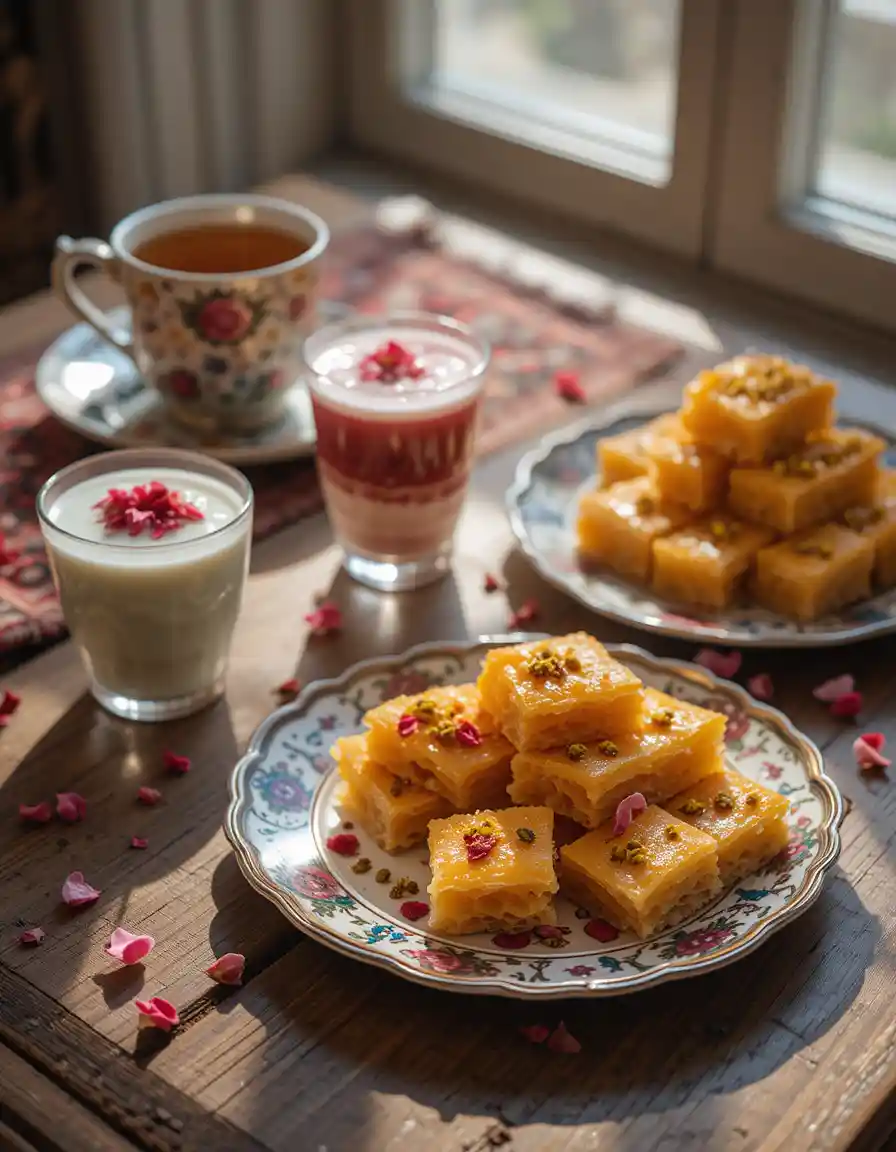
My Final Thoughts on Iranian Desserts
Every time I make one of these Iranian desserts, it feels like I’m bringing a little piece of my childhood and culture into the kitchen. The aromas of saffron, rosewater, and fresh pistachios always take me back to family gatherings, Nowruz celebrations, and quiet evenings with a cup of tea. I hope this guide has helped you not only discover the beauty of Persian sweets but also inspired you to try making them yourself.
Thank you for taking the time to read and explore these recipes with me. If you enjoyed this article, I invite you to browse through more of my posts — you’ll find plenty of tips, recipes, and stories that bring the rich flavors of Persian cuisine right into your home. Nooshe Jan! (Bon appétit!)
Related Recipes
Frequently Asked Questions About Iranian Desserts
What are the most popular Iranian desserts?
The most popular Iranian desserts include Sholeh Zard (saffron rice pudding), Zoolbia & Bamieh (Persian doughnuts), Gaz (Persian nougat), Faloodeh (rosewater sorbet), and Baghlava Yazdi (Yazd-style baklava). These traditional Persian sweets are deeply rooted in Iran’s food culture and are enjoyed during celebrations, holidays, and everyday gatherings.
Are Iranian desserts healthy?
Many Iranian desserts use natural ingredients like saffron, rosewater, pistachios, almonds, and dates, which offer health benefits such as antioxidants, fiber, and healthy fats. While they do contain sugar, the use of whole ingredients makes them a healthier option compared to many processed sweets.
Where can I buy authentic Iranian desserts?
Authentic Iranian desserts can be found in Persian bakeries, Middle Eastern grocery stores, or online specialty shops. If you’re in Iran, local sweet shops in cities like Tehran, Yazd, Isfahan, and Shiraz offer some of the best traditional sweets made fresh daily.
Can I make Persian desserts at home?
Absolutely! Many Persian desserts are surprisingly simple to make at home with a few special ingredients like saffron, rosewater, and fresh nuts. Dishes like Shir Berenj, Sholeh Zard, and Ranginak require basic cooking skills and are great starting points for beginners.
What is the oldest Persian dessert?
One of the oldest known Persian desserts is Faloodeh, believed to date back to the Achaemenid Empire. It remains popular to this day, especially in Shiraz, where it’s served as a refreshing summer treat.


